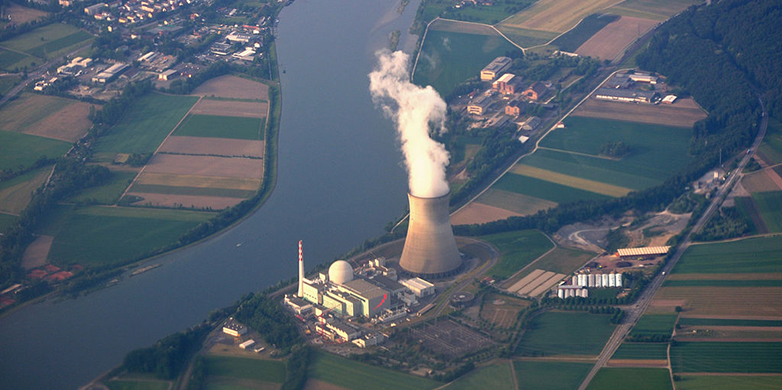Nuclear power: where to next?
Switzerland’s electricity companies, and in particular the operators of its nuclear power plants, are in poor financial shape. Regardless of the outcome of the Nuclear Withdrawal Initiative, the funding required for dismantling and disposal raises issues of state redistribution.
The history of nuclear power has always been highly politicised. In its early days, it was seen as a symbol of technical progress and as a guarantor both of economic strength and of independence in terms of energy policy. Consequently, it benefited from considerable assistance on the part of the state and enjoyed broad cross-party support. Since then, however, the situation has changed.
Nuclear power at a snail’s pace
The decision to withdraw from nuclear power (in the medium term) is already a done deal. Nevertheless, we will vote this month on whether to impose a statutory decommissioning date for all Swiss nuclear power plants. If this proposal is adopted, the operators are threatening to bring a claim against the Confederation for damages running into the billions. [1] Regardless of the result of the vote, the question arises of what form Axpo and Alpiq in particular will take if they still exist in 10 to 20 years. Switzerland’s two biggest electricity companies are in dire financial straits. This is primarily down to the low prices on the distorted European electricity market, unprofitable investments and a lack of end customer business. The nuclear power plants themselves are barely profitable at present, and only recently Alpiq offered its shares in Gösgen and Leibstadt to other energy companies as a gift. [2] This offer was rejected.
Safety as a question of faith
From an economic perspective, nuclear power has never repaid its full cost to society. Whereas coal is currently profiting from excessively low carbon prices, nuclear power is profiting from a failure to insure against the risks of a nuclear accident, for example. Unlike for larger nations, this represents a sort of “all-in” risk for a small country like Switzerland. Quantifying this risk is barely possible, as it effectively involves multiplying zero by infinity: although the probability of occurrence is quite low, the resulting damage would be immense, partly because it would impact intangible assets such as our “homeland”. Whether Switzerland should take a risk on this scale therefore also comes down to a question of faith.
An uncertain future
You either believe in the economic viability of nuclear power or you don’t. If you consider the expected market prices over the next ten years, it is doubtful whether – from a business management perspective – the existing nuclear power plants will be able to cover their fixed costs. Investments in renewal will probably be seen increasingly as unprofitable. Particularly in the case of Beznau 1, where the closure head of the reactor pressure vessel had to be replaced because of inclusions, I doubt whether the plant will ever be brought on stream again. Inclusions in the shroud mean that Axpo would also have to replace this beforehand, which would be tantamount in cost to decommissioning.
The cost of decommissioning
The owners of the nuclear power plants are legally obliged to dispose of radioactive waste safely and at their own expense. Two independent funds are accumulated for this purpose: the Decommissioning Fund and the Disposal Fund. According to estimates from 2011, which were authenticated by ENSI, the decommissioning of Switzerland’s five nuclear power plants and the central interim storage facility would cost approximately 2.97 billion francs. [3] Worldwide, however, there is little past experience from which to derive figures. Germany, for example, expects the amounts to be significantly higher. [4] The Swiss estimates are currently being updated. At the end of 2015, the accumulated capital in the Decommissioning Fund was approximately 2 billion francs. The estimated cost of disposal of operational waste and fuel elements runs to almost 16 billion in total. Of this, 9.7 billion is already covered or has already been paid out in the form of ongoing disposal costs. In total, more than 6.3 billion of the current estimated costs is therefore still outstanding.
Too big to fail
A significant proportion of the fund’s holdings should still be generated from interest income. However, low interest rates and low electricity prices are making it difficult for the companies to build up the funds further. If they fail to raise the money required for dismantling the nuclear power plants in time, they run the risk of bankruptcy. Should this happen, the Confederation would probably step in on moral grounds and out of concerns over safety. The principal shareholders of Axpo and Alpiq, i.e. the cantons and cities, are conscious of this. In some cases, they have posted the shares in their accounts at nominal values. This means that the financial damage they would incur would be relatively minor, with the exception of any lost dividends that, in the past, had been highly profitable.
A question of redistribution
One thing is certain: the costs of nuclear power will ultimately be met by the Swiss people. We can now ask ourselves how the bill for this is best shared out or, rather, socialised: through tax receipts or electricity prices? Whereas taxes have a progressive effect (those who have more pay more), price increases are regressive in nature (those who have less pay more in relative terms), especially when it comes to electricity. However, the advantage of the latter is that the cost would be met primarily by those using the energy.
Further information
[1] external pageArticlecall_made in the Tagesanzeiger
[2] external pageArticlecall_made int the Sonntagszeitung
[3] Eidgenössisches Nuklearsicherheitsinspektorat external pageENSIcall_made
[4] external pageArticlecall_made SRF


